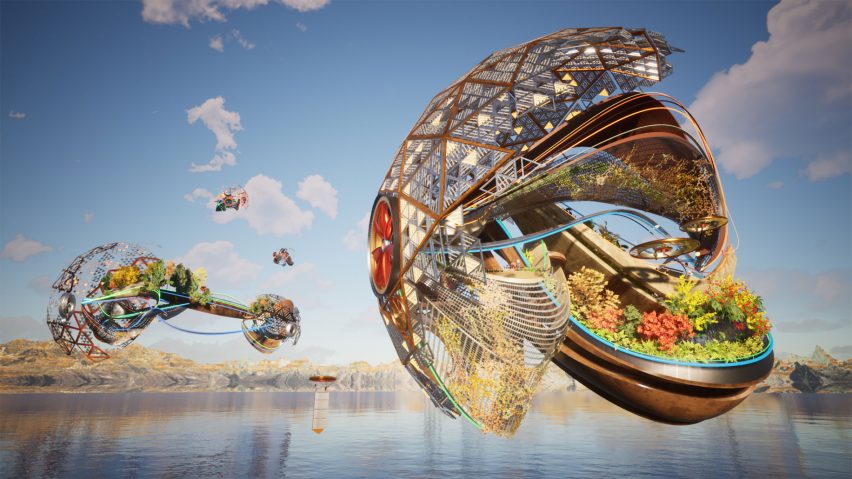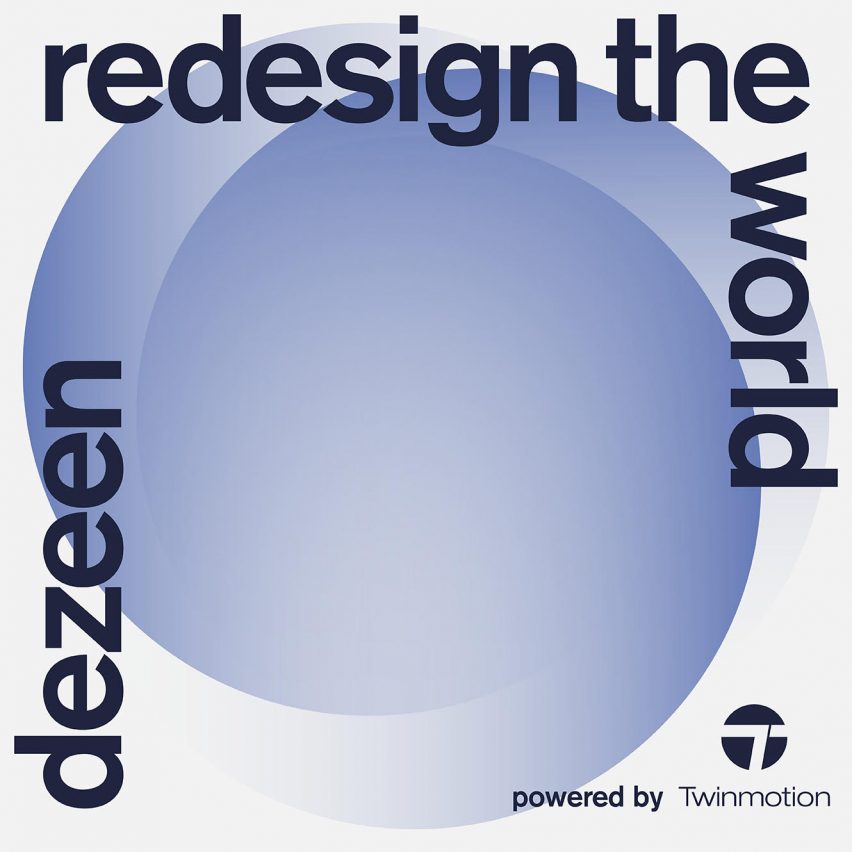Bless Yee's vision for carbon-capturing "living infrastructures" wins joint third place in the Redesign the World contest
Bless Yee's proposal for floating habitats that capture carbon from the air has been awarded joint third place by the judges of Dezeen's Redesign the World competition powered by Twinmotion.
Named Carbon Capture Refuge X, Yee's project imagines a world where scientists have developed a network of floating living environments that sit within the Earth's troposphere.
These habitats are home to refugees who are engaged in environmental research, Yee imagines.
Each infrastructure features solar panels and direct-air-capture fans that extract carbon from the atmosphere, converting it into electrical energy.
The energy runs through neon strips within the infrastructure's floors, walls, and roofs.
Yee describes the strips as "veins" designed to circulate utilities throughout the structure. They also act like "muscles" that elongate to accommodate the system's growth and open and close depending on the weather to allow air and natural light inside.
Yee's entry "showcases achievable technologies"
Yee's entry has been named joint third place in the Redesign the World competition. The other third-placed entry will be revealed tomorrow.
"Yee's entry is an imaginative vision for a floating, technologically advanced future city," said the Redesign the World judges.
"Despite seeming farfetched, the concept actually showcases achievable technologies such as carbon capture, which will have an important role to play in reversing climate change."
Read more about the proposal below.

Carbon Capture Refuge X
Bless Yee, New York, United States
Joint third place
"War-ravaged by political upheaval and nearly rendered uninhabitable by natural disasters, earth's refugees became ubiquitous.
"From the suffering and desperation, a manifestation to live with the earth and not just on the earth emerged. Scientists then developed a habitable living infrastructure known as Carbon Capture Refuge X (CCRX).
"This living infrastructure simultaneously provided a sustainable way of living while filtering carbon out of the atmosphere.
"Earth's magnetic field was utilized to suspend the CCRXs above the ground and sea, thus creating a floating habitable layer in the troposphere.
"As the CCRXs developed, refugees took to the sky, and a great migration began. At the heart of this living infrastructure are solar panels and DAC (direct air capture) fans.
"The DAC fans extract carbon from the atmosphere and convert it into electrical energy. Then the collected energy is dispersed through neon strips that integrate with the walls, floors, and roofs of the structure.
"The functions of these neon strips are two-fold. They are the veins that circulate utilities throughout the space, and they are the muscles that can open a space to allow air and light in, close for inclement weather, or elongate to accommodate growth.
"The physical structure of the CCRXs are continuously evolving. Rainwater collection is stored and filtered by vegetation and then used to supplement hydroponic farming.
"The vegetation creates a localised microclimate. A control centre monitors the comfort, location, and communications of the CCRX. Inhabitants are often engaged in environmental research.
"Drones are used as the main distributors of goods, and they transport goods from one CCRX to another. As the CCRXs flourished and multiplied, the need for larger living infrastructures grew, and units began to connect and plug into one another.
"Some merged into floating farms and pastures, others into floating forests etc., gradually restoring microclimates and ecosystems that were nearly obsolete. The CCRXs now fill the sky in which there are no borders.
"They migrate freely, floating as one with the earth."

Redesign the World
Redesign the World is the ultimate design competition, which called for new ideas to rethink planet Earth to ensure that it remains habitable long into the future.
Launched in partnership with Epic Games, the contest asked entrants to visualise their concepts using architectural visualisation software Twinmotion.
The contest received over 100 entries from more than 30 different countries around the world.
These were assessed by a judging panel comprising White Arkitekter CEO Alexandra Hagen, structural engineer Hanif Kara, speculative architect Liam Young, Twinmotion product marketing manager Belinda Ercan and Dezeen founder and editor-in-chief Marcus Fairs, which selected 15 proposals as finalists to be published on Dezeen.
We are unveiling one finalist a day throughout our Dezeen 15 festival, culminating in the winner being announced on 19 November.
The winner will receive the top prize of £5,000. There are also prizes of £2,500 for second place, £1,000 for third place and £500 each for the remaining finalists.
Find out more about Redesign the World ›
See all the finalists revealed so far ›